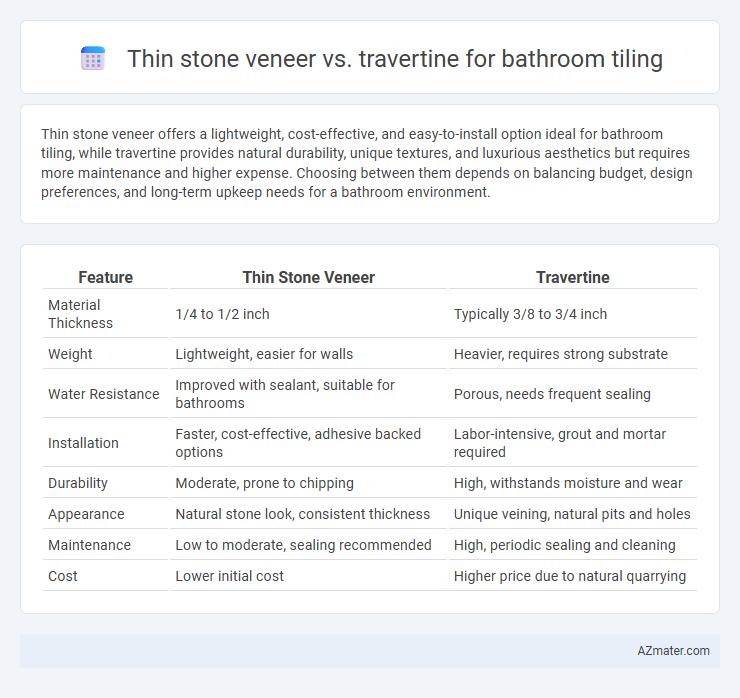Thin stone veneer offers a lightweight, cost-effective, and easy-to-install option ideal for bathroom tiling, while travertine provides natural durability, unique textures, and luxurious aesthetics but requires more maintenance and higher expense. Choosing between them depends on balancing budget, design preferences, and long-term upkeep needs for a bathroom environment.
Table of Comparison
| Feature | Thin Stone Veneer | Travertine |
|---|---|---|
| Material Thickness | 1/4 to 1/2 inch | Typically 3/8 to 3/4 inch |
| Weight | Lightweight, easier for walls | Heavier, requires strong substrate |
| Water Resistance | Improved with sealant, suitable for bathrooms | Porous, needs frequent sealing |
| Installation | Faster, cost-effective, adhesive backed options | Labor-intensive, grout and mortar required |
| Durability | Moderate, prone to chipping | High, withstands moisture and wear |
| Appearance | Natural stone look, consistent thickness | Unique veining, natural pits and holes |
| Maintenance | Low to moderate, sealing recommended | High, periodic sealing and cleaning |
| Cost | Lower initial cost | Higher price due to natural quarrying |
Introduction: Choosing the Right Bathroom Tiling Material
Thin stone veneer offers a lightweight and cost-effective option for bathroom tiling, providing natural stone aesthetics with easier installation compared to traditional stone. Travertine, characterized by its porous texture and warm earth tones, delivers a classic and high-end look but requires regular sealing to maintain durability in moist environments. Selecting between thin stone veneer and travertine hinges on balancing factors like budget, maintenance commitment, and desired visual appeal for a long-lasting bathroom design.
Overview of Thin Stone Veneer
Thin stone veneer offers a lightweight and versatile alternative to traditional travertine for bathroom tiling, providing the natural stone aesthetic with easier installation and reduced structural load. This material typically consists of real stone cut into thin slices, allowing for seamless application on walls and surfaces where full-thickness stone would be impractical. Thin stone veneer's durability, water resistance, and wide range of textures make it ideal for bathroom environments, combining beauty with functional performance.
Overview of Travertine Tiles
Travertine tiles, a natural stone formed from calcium carbonate deposits, offer a rich texture and warm earth tones ideal for luxurious bathroom tiling. Thin stone veneer provides a lightweight, cost-effective alternative with easier installation, but lacks the depth and natural variation of full travertine tiles. Travertine's durability and classic veining patterns make it a preferred choice for high-end bathroom designs seeking elegance and natural beauty.
Aesthetic Appeal: Design and Color Variations
Thin stone veneer offers a sleek, modern aesthetic with a wide range of natural textures and subtle color variations, ideal for creating a contemporary bathroom ambiance. Travertine exudes classic elegance with warm, earthy tones and unique veining patterns that provide a timeless, luxurious appearance. Both materials enhance bathroom design flexibility, but travertine's rich color palette and organic veining deliver a more traditional and opulent visual impact.
Durability and Water Resistance
Thin stone veneer offers excellent water resistance due to its dense composition and sealed surface, making it a durable option for bathroom tiling. Travertine, while aesthetically pleasing with its natural texture, requires regular sealing to prevent water absorption and potential damage. For long-term durability and resistance to moisture, thin stone veneer generally outperforms travertine in bathroom environments.
Installation and Maintenance Requirements
Thin stone veneer offers easier installation due to its lightweight and thinner profile, requiring less structural support and reducing labor costs compared to traditional travertine slabs. Travertine, while durable and natural, demands meticulous sealing and regular maintenance to prevent water absorption and staining in bathroom settings. Both options benefit from professional installation to ensure longevity, but thin stone veneer minimizes installation complexity and maintenance frequency.
Cost Comparison: Thin Stone Veneer vs Travertine
Thin stone veneer typically costs between $7 to $15 per square foot, offering a budget-friendly option for bathroom tiling compared to travertine, which ranges from $10 to $30 per square foot depending on quality and source. Installation costs for thin stone veneer are generally lower due to its lightweight nature, reducing labor expenses, while travertine requires skilled craftsmanship and specialized tools, increasing installation fees. Maintenance costs also favor thin stone veneer, as travertine demands regular sealing and care to prevent staining and damage in humid bathroom environments.
Environmental Impact and Sustainability
Thin stone veneer offers a more sustainable option for bathroom tiling due to its reduced material usage and lighter weight, which lowers transportation emissions compared to traditional travertine slabs. Travertine, while natural and durable, often requires extensive quarrying that can result in significant habitat disruption and higher carbon footprints. Selecting thin stone veneer not only conserves natural stone resources but also supports eco-friendly bathroom design by minimizing waste and energy consumption during installation.
Suitability for Wet Areas: Shower Walls and Floors
Thin stone veneer offers excellent durability and moisture resistance, making it suitable for shower walls but requires proper sealing to prevent water penetration. Travertine, known for its natural porosity, is less ideal for shower floors unless sealed thoroughly, as it can absorb water and stain easily. For wet areas, thin stone veneer provides a more practical and low-maintenance option compared to travertine, which needs regular upkeep to maintain its appearance and functionality.
Final Verdict: Which Material is Best for Your Bathroom?
Thin stone veneer offers a lightweight, cost-effective solution with easy installation, ideal for creating a natural stone look without excessive weight or expense. Travertine provides a luxurious, durable option with unique texture and classic beauty but requires more maintenance and sealing to prevent water damage in bathroom environments. Choosing between thin stone veneer and travertine depends on your budget, desired aesthetic, and willingness to maintain the surface regularly for long-lasting bathroom tiling results.

Infographic: Thin stone veneer vs Travertine for Bathroom tiling
 azmater.com
azmater.com